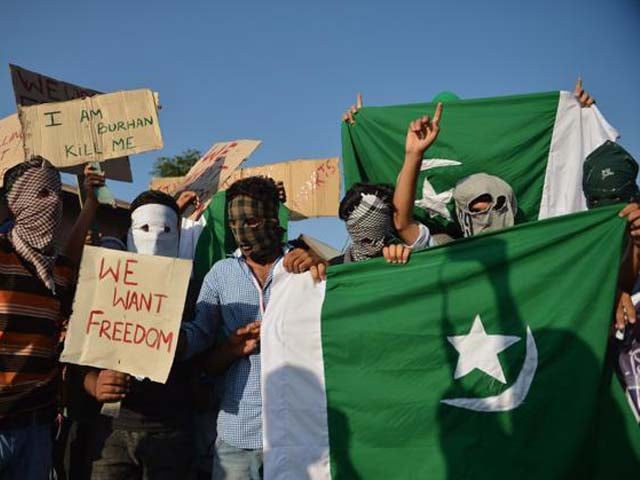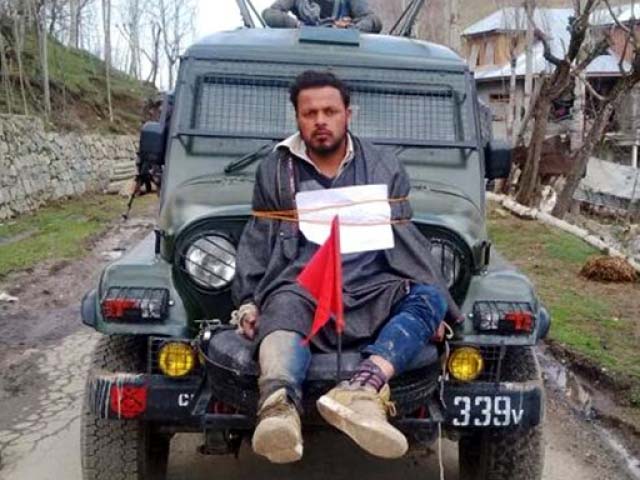
No Muharram in Kashmir again - 25 years and counting
India thinks that religious gatherings, like in Muharram, could possibly turn into pro-freedom rallies in Kashmir.
I recall attending a brief lecture on international law vividly. A learned professor was making a point on the integration of minorities and how nation states often misuse tools like assimilation, accommodation, tolerance, pluralism and multiculturalism etcetera to coerce minorities into submission. When everything fails to get the desired results, the law and order argument achieves significance and becomes fashionable.
This brings me to the issue that has had Indian-administered Jammu and Kashmir in a stranglehold for nearly two and a half decades now; the blanket ban on the historic Muharram processions. The argument usually put forth by the Indian think-tank, intellectuals and intelligentsia, against the Kashmiri narrative of a right to self-determination, is that India is the world’s largest democracy, which, they claim, has the capacity to accommodate cultural, religious, linguistic, ethnic and other diversities. They often say that Kashmir’s future is bright and secure with the emerging world power and ‘tolerant’ India. India’s oft-repeated symbolic slogan to hoodwink the international community in this respect is “Unity in Diversity”. But reality on the ground is different. This ban has been in place since the past 25 years and ironically, this year the ban completes its silver jubilee.
Soon after the eruption of a popular anti-Indian armed rebellion, the region’s then ruthless governor, Mr Jagmohan Malhotra, imposed a ban on the processions (8th and 10th) in 1989. This unwanted interference in the religious freedom of the Kashmiris, a denial of right to movement and also a brazen violation of international law remains intact despite India’s claim that the ‘democratically’ elected governments run the show in Jammu and Kashmir, not the Indian security establishment.
Before 1989, the two main Muharram processions in Kashmir valley would take place in the city centre, Lal Chowk. The Indian authorities apprehend that such religious assemblies could further alienate the people of Jammu and Kashmir from the Indian Union by stroking anti-India sentiment. However, the resistance and religious leaders of Kashmir argue that the same authorities in Jammu and Kashmir fully expose themselves by allowing and facilitating the environmentally-unfriendly Hindu nationalistic Amaranth yatra pilgrimage in an ecologically fragile zone of Pahalgam and breach the religious freedom of the majority Muslim community. At least half a million Indian Hindu pilgrims visit the holy Amaranth cave in Pahalgam region annually.
Sources in the Jammu Kashmir police confirm that the security establishment is in no mood to lift the ban on the two biggest Muharram processions this time around either. Several prominent Shiite leaders, including Moulana Sibte Muhammad Shabir Qumi of Pairwan-e-Willayat, have urged the state government to put an end to the unjust restrictions placed. But such rational appeals often fall on deaf ears in this disputed Himalayan region.
In January 2008, the Kashmir valley based Shiite organisation named Ittihadul Muslimeen filed a petition in the Jammu Kashmir High Court seeking quashing of the ban clamped by the former governor. The single bench of Justice Mansoor Ahmad Mir had directed the then additional advocate general, the financial commissioner, divisional commissioner and district magistrate of Srinagar to file objections within four weeks. But nothing substantial has happened since.
One wonders what the possible reasons behind the government’s decision could be. Why can the people not commemorate the martyrdom of their religious heroes and express their love through religious rituals?
Many intellectuals in Kashmir are of the view that India only treats Kashmir as a security problem and therefore exercises extra caution, thinking that any substantial religious gathering, like in Muharram, could possibly turn into a pro-freedom rally and thus challenge India’s rule in Kashmir.
The Indian state is also wary of the potential of the Muharram processions and may think they will be used as a platform to forge permanent Shiite-Sunni unity, which in effect would dismantle and challenge the facile Indian argument that different religious sects and groups in Jammu and Kashmir profess different ideologies. The other reason perhaps could be that the state does not want to offer any chance on a platter to the resistance leadership in the Kashmir valley to use a religious gathering as a rallying point. Security experts during off-the-record conversations have in fact insisted that they don’t want any possible law and order situations in Kashmir.
Another thought that raised suspicions was that the Indian Prime Minister, Narendra Modi, chose Diwali, a festival of lights celebrated by Hindus in mainland India, to visit Kashmir to express solidarity with the flood affectees of Jammu and Kashmir – the only Indian-controlled Muslim majority region. Mr Modi did not choose Eid to announce relief package for the flood victims and even on his Diwali visit to Kashmir, he first met the Indian soldiers stationed at the Siachen glaciers before he moved on to the Muslim affectees.
Meanwhile, in areas that are pre-dominantly Shiite, Muharram preparations have intensified; banners and billboards exhibiting religious messages, the importance of the Battle of Karbala and martyrdom of Imam Hussain (ra), the grandson of the prophet of Islam, Hazrat Muhammad (pbuh) have been displayed everywhere.
Apart from this blatant breach of religious freedom, the authorities in the Kashmir valley arrested at least a dozen resistance leaders, on Thursday, including the Jammu and Kashmir Liberation Front (JKLF) chief, Yasin Malik, chief of a faction of the pro-freedom Hurriyat conference, Shabir Shah, chairman of the National, along with many others. It is unclear whether these leaders have been arrested to thwart the chances of their attempts to organise possible Muharram gatherings or to neutralise their planned election boycott campaigns. The Election Commission of India has already announced dates for the five-phased assembly polls in Jammu and Kashmir, beginning November 25. The one thing that is very clear from the picture I have drawn for you is that there is no religious freedom in this part of ‘democratic’ Indian-administered Kashmir.




COMMENTS (77)
Comments are moderated and generally will be posted if they are on-topic and not abusive.
For more information, please see our Comments FAQ